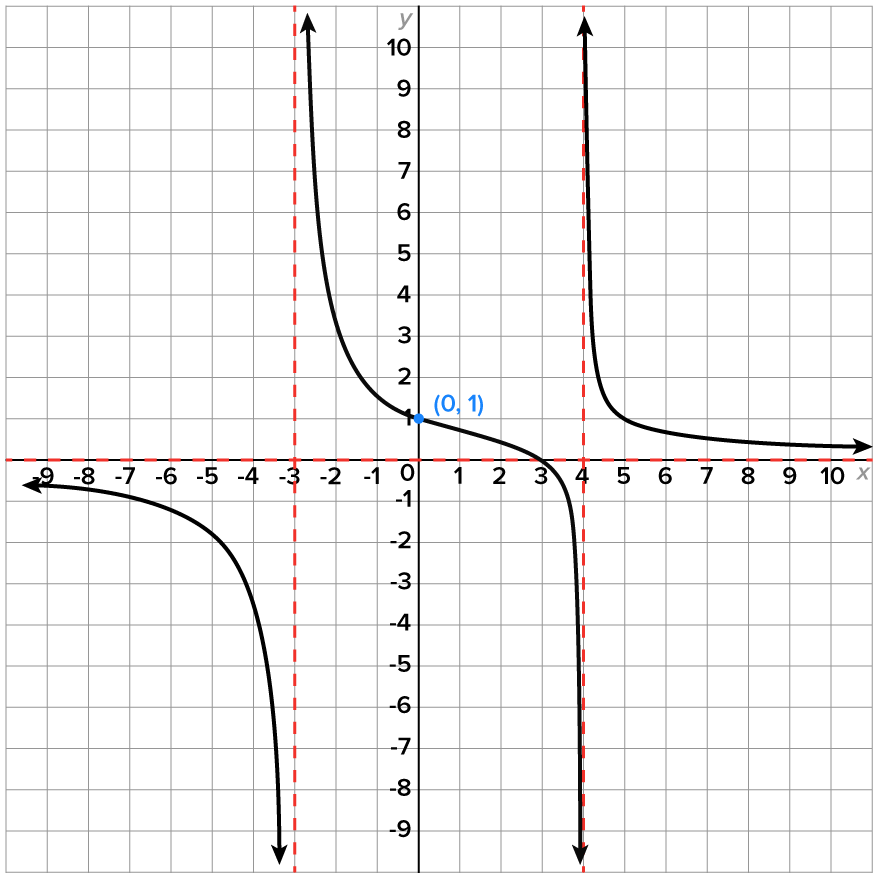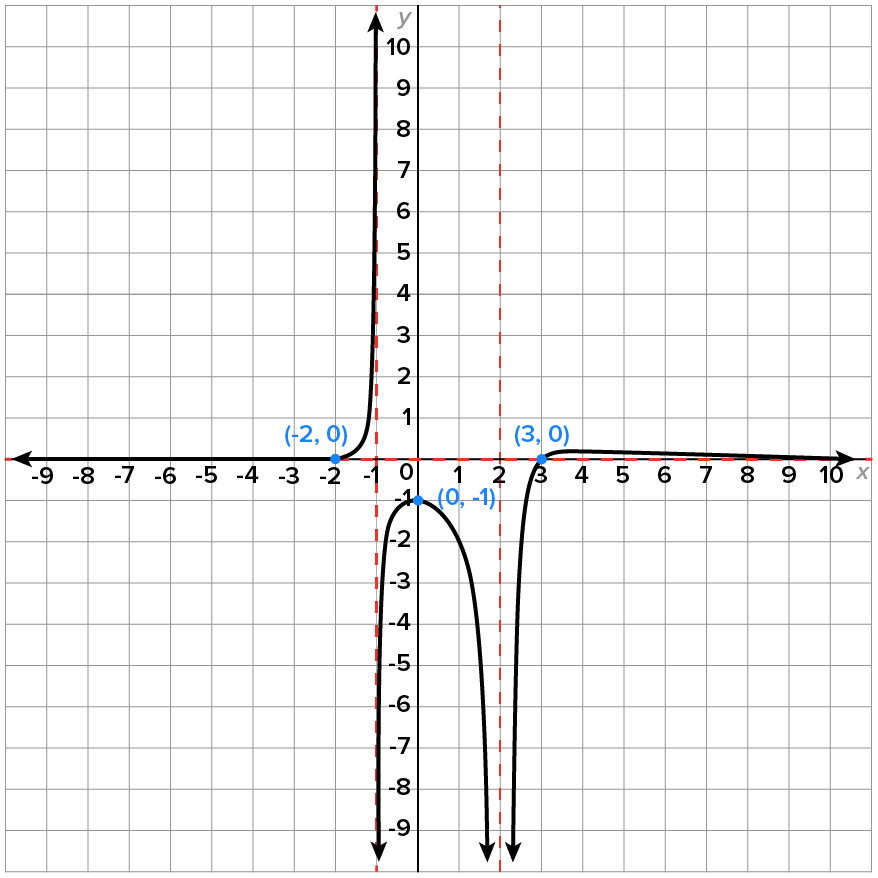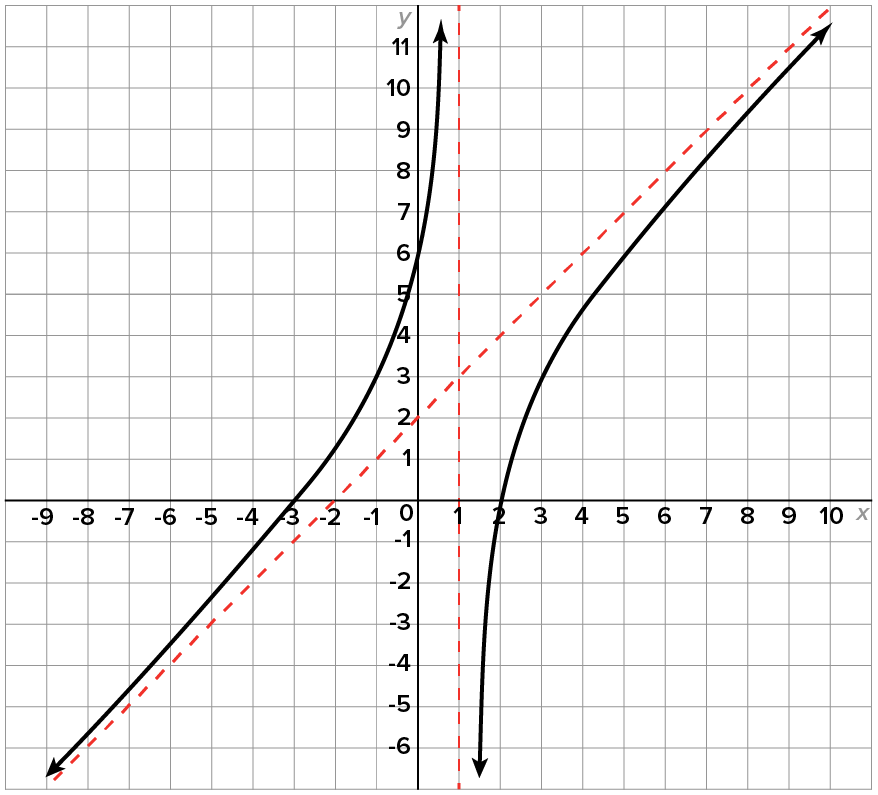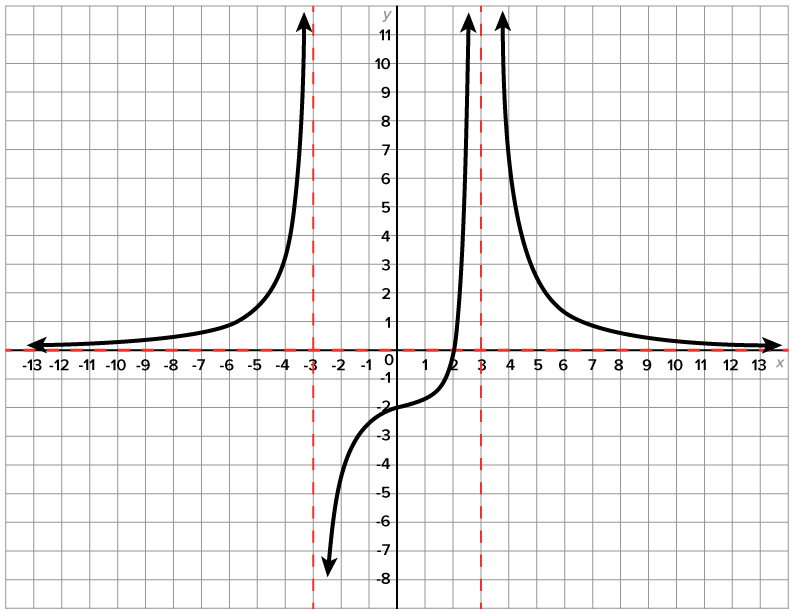Earlier, we were using the equation of a rational function to determine all its characteristics. Because of the relationship between the equation and these characteristics, we can also write a possible equation of a rational function if we know its characteristics.
EXAMPLE
Write an equation of the rational function whose graph is shown here.
 This suggests that the degree of the numerator is smaller than the degree of the denominator.
This suggests that the degree of the numerator is smaller than the degree of the denominator.  and
and 


 and
and  which means that the denominator contains
which means that the denominator contains  and
and  as factors. Upon further inspection, the behavior of the graph around the asymptotes suggests that each has odd multiplicity (
as factors. Upon further inspection, the behavior of the graph around the asymptotes suggests that each has odd multiplicity ( on one side of the asymptote and
on one side of the asymptote and  on the other side). Thus, the factored form of the denominator is
on the other side). Thus, the factored form of the denominator is 
 which means that
which means that  is a factor of the numerator.
is a factor of the numerator.
 where
where  is a stretch factor that isn’t apparent from the graph. Similar to our work with polynomials, we use another point on the graph to determine what the value of
is a stretch factor that isn’t apparent from the graph. Similar to our work with polynomials, we use another point on the graph to determine what the value of  is. In this case, we use the y-intercept.
is. In this case, we use the y-intercept.
 we know
we know  By our equation,
By our equation, 
 which means
which means 
 which is also written
which is also written 
Now that we have worked through one example, here are some steps to follow when building an equation of a rational function.
Now, let’s look at a more involved example.
EXAMPLE
Write an equation of the rational function whose graph is shown below.
 This suggests that the degree of the numerator is smaller than the degree of the denominator.
This suggests that the degree of the numerator is smaller than the degree of the denominator.  and
and 
 and
and 

 and
and  which means that the denominator contains
which means that the denominator contains  and
and  as factors.
as factors.
 suggests odd multiplicity since
suggests odd multiplicity since  on one side and
on one side and  on the other side.
on the other side.
 suggests even multiplicity since
suggests even multiplicity since  on both sides of
on both sides of  Therefore, the factored form of the denominator is
Therefore, the factored form of the denominator is 
 and
and  which means that
which means that  and
and  are factors of the numerator. Since the graph crosses the x-axis at each intercept, each factor has odd multiplicity, so we will assume that each is linear (multiplicity 1). Then, the numerator is
are factors of the numerator. Since the graph crosses the x-axis at each intercept, each factor has odd multiplicity, so we will assume that each is linear (multiplicity 1). Then, the numerator is 
 where
where  is a stretch factor that isn’t apparent from the graph. Similar to our work with polynomials, we use another point on the graph to determine what the value of
is a stretch factor that isn’t apparent from the graph. Similar to our work with polynomials, we use another point on the graph to determine what the value of  is. In this case, we use the y-intercept.
is. In this case, we use the y-intercept.
 we know
we know  By our equation,
By our equation, 
 which means
which means 
 which is also written
which is also written 
Here is one more worked-out example that involves an oblique asymptote.
EXAMPLE
Write an equation of the rational function whose graph is shown here.

 and
and 

 on one side of the vertical asymptote and
on one side of the vertical asymptote and  on the other side,
on the other side,  has odd multiplicity. This means that the denominator is
has odd multiplicity. This means that the denominator is 
 corresponds to
corresponds to  and
and  corresponds to
corresponds to  the factored form of the numerator is
the factored form of the numerator is 
 for some stretch factor
for some stretch factor 
 we know
we know 

 which means
which means 
 or
or 

Well, hello. In this video, we're going to look at how to write the equation of a rational function whose graph is given. Now when we look at this graph, one of the first things we want to note is that there is a hole in the graph at the point negative 1, comma 4. So with that hole in the graph at negative 1, comma 4, I know that x minus negative 1 or x plus 1 is a common factor of both the numerator and the denominator.
So we are going to start by giving structure to what we're going to fill in, and then, with that hole in the graph, realize, that we have that common factor of x plus 1 in the numerator in the denominator because of the hole in the graph.
Next up, we see that there is a vertical asymptote at x equal 1. And if there's a vertical asymptote for the graph, I know that x minus that value-- so x minus 1-- is a factor in the denominator, but not in the numerator.
One thing that we want to realize is when we're writing this equation of a rational function, we want to write it where we have the smallest degree possible of the numerator and denominator. And so while there are a lot of other ones that you can write, we want to write the one with the lowest degrees.
Next up, we see that there is an x-intercept at x equal 3, comma 0. So that means that there is a factor of x minus 3 in the numerator of the function.
Now that we have that part of the function set up from all of that information, we need to find our value of a, which is the stretch of the graph. And we can do that by finding a point on the function that lends us to having an easy way of finding it. And that is using our y-intercept.
So the y-intercept on this graph is 0, comma 6. So that means when 0 goes in for the function, 6 comes out. Now if we take f of 0 in our structured form, that's a times 0 plus 1 times 0 minus 3 over 0 plus 1 times 0 minus 1. And so that gives us that f of 0 is equal to 3a.
But I also know that I have the y-intercept of 0, comma 6. So if 0 goes into the function, 6 is my output. So that means, then, that 3a has to be the same as 6.
Solving for a, I get a is equal to 2. And then that gives me my final form of my function, f of x is equal to-- well, one step shy of final form of my function. It's 2 times the x plus 1 times x minus 3 over x plus 1 times x minus 1, which we can write with our 2 in the numerator.
And multiplied out and distribute the 2 through the numerator-- we have 2x squared minus 4x minus 6, all over x squared minus 1. And that is the equation of the function that has the given graph.
Earlier, we discussed real-life situations that were modeled by rational functions. Since we know so many more characteristics of rational functions now, they can be interpreted with real-life meaning.
EXAMPLE
Suppose you have a saltwater solution that contains 5 pounds of salt dissolved in 50 gallons of water. A tap is turned on that adds 4 gallons of water to the solution each minute, and at the same time, 0.5 pounds of salt is added each minute. where t is the number of minutes since the water was turned on.
where t is the number of minutes since the water was turned on.

|
|
Set the denominator equal to 0. |

|
|
Solve for t. |

SOURCE: THIS WORK IS ADAPTED FROM PRECALCULUS BY JAY ABRAMSON. ACCESS FOR FREE AT OPENSTAX.ORG/BOOKS/PRECALCULUS/PAGES/1-INTRODUCTION-TO-FUNCTIONS